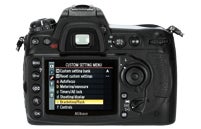Essential guides to getting more from your photography
Our range of guides are written so you can read them without any prior knowledge of photography. Choose the one’s you are most interested in, or read them all for a good grounding in what to do with your camera.
![Custom setting menu]() Setting up
Setting up
Before you being to take images with your camera you should choose the settings to meet your requirements. Our guide includes setting the video mode, image settings, colour space and screen settings.
See our guide to setting up your camera
Viewing
There are a number of ways that you can view the scene you’re about to take, we guide you though the various options, including using LCD screens, electronic viewfinders, optical viewfinders, live view and selecting viewing options.
See our guide to a camera’s viewing options
![Shallow depth of field]() Focusing
Focusing
There are many different focusing options that can be set to fit a particular situation, including different focusing moves, focusing points, face detection features, AF assist lamp and separate focus and shutter buttons.
See our advice on focusing your camera
Focal length
Different lenses cover different angles of view. The angle they can cover is determined by its focal length. We discuss focal length and look at standard lenses, wideangle lenses and telephotos.
![Drive mode]() Shutter release modes
Shutter release modes
Your camera offers different shutter release modes which affect the timing of the image being taken. We look at single mode, self timer, continuous mode, intervalometers (to take time lapse photographs) and remote releases.
See our guide to shutter release modes
![White balance]() White balance
White balance
Setting the white balance ensures that colours are recorded accurately, taking the lighting into consideration. We guide you through measuring white balance, manual temperature selection, mixed lighting, white balance pre-sets and shooting RAW.
![ISO 1600]() ISO settings
ISO settings
The ISO setting controls the sensitivity of the camera’s sensor. High settings can cause image quality issues. Find out more about sensor sensitivity, High ISOs and the issues attached, the ISO scale and when to use higher ISOs.
![Apeture]() Apertures
Apertures
‘Aperture’ refers to the hole in the lens and, together with shutter speed, controls the amount of light reaching the sensor. It can make a dramatic difference to the zone of focus of your image. We explain the affects of adjusting aperture, the aperture scale, depth of field and what is meant by ‘fast’ lenses.
![Jetski]() Shutter speed
Shutter speed
The shutter speed controls the length of your exposure. The shutter speed affects the way that motion is recorded by your camera. See how to control exposure, avoid camera shake, freeze motion, blur motion and pan.
![Exposure]() Exposure and metering
Exposure and metering
Get the amount of light entering your camera wrong and your picture could be too dark or too light. Use your cameras metering system to make sure you get it right. We explain subject brightness, metering moves, and how to override the meter.
See our guide to exposure and metering
![Histogram]() Advanced exposure
Advanced exposure
There are a number of tools built into your camera that are designed to assist and complement the built-in exposure meter. We look at the histogram, bracketing, dynamic range adjustment, and High Dynamic Range photography.
![Scene Modes]() Auto modes
Auto modes
Most cameras offer a range of shooting modes that you can set depending on your circumstances. These include intelligent auto and a number of scene modes such as action, landscapes, portrait and close up.
![Creative exposure modes]() Creative modes
Creative modes
Creative exposure modes, such as program, aperture priority and shutter priority, allow you to take more control of how your pictures will look. We explain how to use these modes.
![Flash]() Flash modes
Flash modes
In some conditions flash can save your shot, at other times it can spoil it. See how to use auto flash, redeye reduction, rear curtain sync, fill in flash and flash exposure compensation.
![Movie mode]() Movie mode
Movie mode
If you follow a few simple rules you can get fantastic results from a camera’s movie mode. See our shooting and editing tips and information on the limitations of shooting movies on your still camera.
![Playback menu]() Image review
Image review
There are a number of ways you can review a picture that you have taken, such as using EXIF data, histogram, shadow/highlight, auto rotate, image magnification and by viewing externally.
![Dynamic range enhancement]() In camera processing
In camera processing
Many cameras let you to adjust and enhance to your shots afterwards, whilst still in the camera. We look at redeye correction, D-Lighting, cropping, straightening, resizing, perspective control, beauty mode, colour effect and RAW processing.
In camera processing explained
![Custom setting menu]() Advanced menu options
Advanced menu options
There are lots of advanced options that can be of help once you’ve mastered the basic options. These include file management, noise reduction, custom functions, interval timer, multiple exposure and flash settings. Find out more about how these work.
![Lens types]() Extra lenses
Extra lenses
The kit lens that comes with your camera had its limitations. You might want to consider adding other lenses to your collection. We look at the other lenses available and discuss what to look out for when choosing, such as focal length, maximum aperture, minimum focus etc.
![Camera bag]() Accessories
Accessories
There are lots of accessories to choose from to add to your camera, we look at a few of the most essential, such as flashgun, tripod, remote release, filters and bags.
More info on camera accessories
Still hungry for more? Now that you’ve mastered the basics of your camera take a look at our technique tips on how to take certain types of shots.





